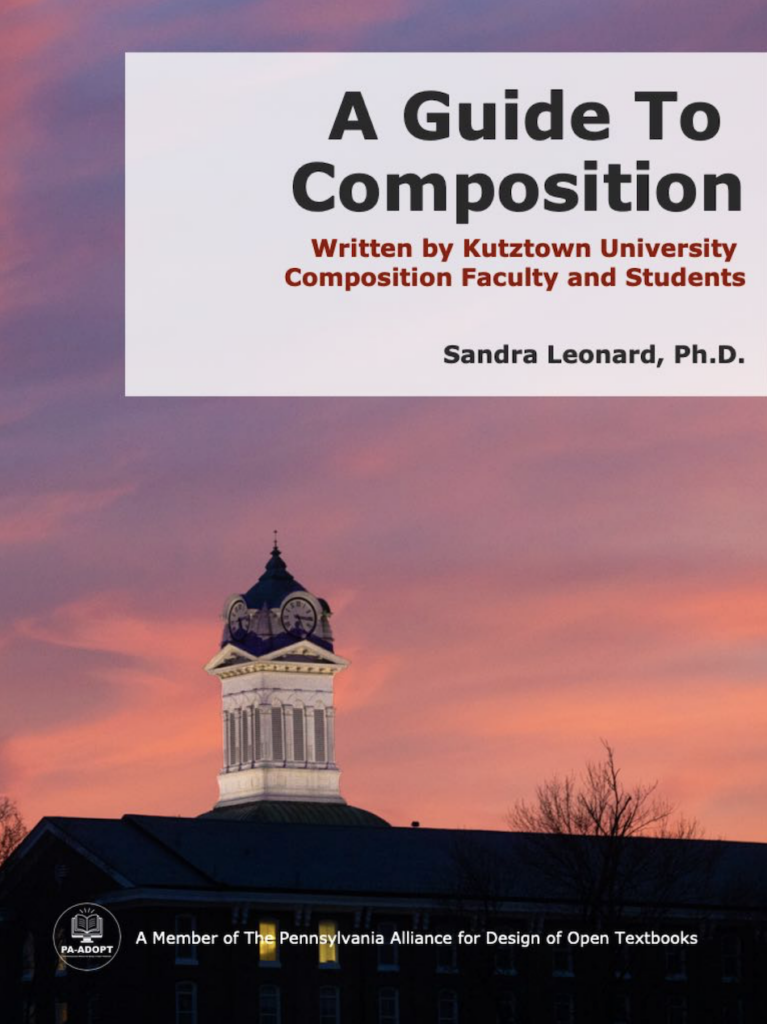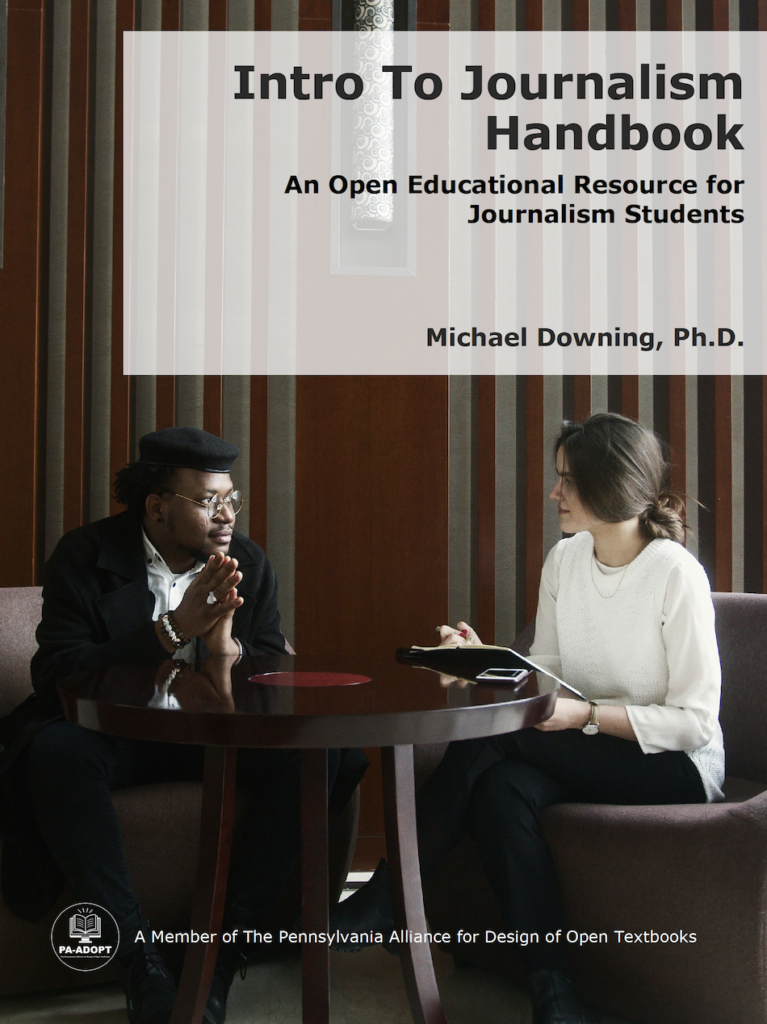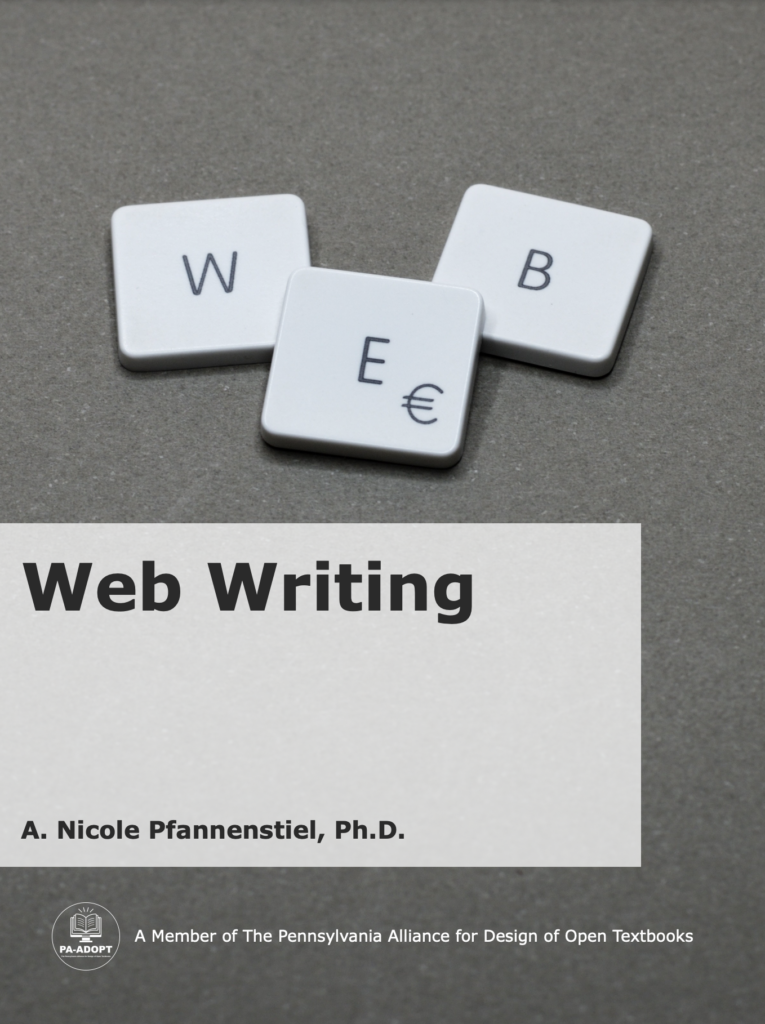
The Pennsylvania Alliance for Design of Open Textbooks (PA-ADOPT) is pleased to announce the immediate availability of our thirteenth free and open eTextbook: Making Meaning With & Through Writing: An Approach to Research Writing by Dr. Ilknur Sancak-Marusa, Assistant Professor of English at West Chester University.
“Academic writing is an act of intellectual translation which converts raw ideas into academic discourse to bridge the gap between writer and reader. However, writing is often viewed as a mechanical skill rather than an intellectual craft. This brief text reframes academic writing as a translation process that transforms complex thoughts, research findings, and abstract concepts into purposeful, persuasive writing.
Using the writing process as the foundation, each chapter aims to provide a practice to navigate the recursive nature of writing. To that end, fundamental translation principles are utilized to analyze audience needs, understand scholarly articles, synthesize and craft arguments that resonate across disciplinary boundaries.
Writing isn’t separate from thinking as it allows us to refine our ideas and share them with others in meaningful ways. Embracing this connection between writing and its impact, positions an individual as an active participant rather than a passive observer in conversations that shape disciplines and the world-at-large. This writing guide seeks to equip students with the essential tools needed to engage meaningfully in the communities they serve and soon will discover.”
Please help us spread the word about our books and web site to further our work to reduce costs for students, bring equity to higher education classrooms, and give faculty the flexibility to design their own learning experiences. All of our books are available to download in both ePub and PDF formats from our Bookshelf.

The Pennsylvania Alliance for Design of Open Textbooks (PA-ADOPT) is pleased to announce the immediate availability of our tenth free and open eTextbook: A Guide to Compostition by Dr. Sandra Leonard, Associate Professor of English at Kutztown University.
“A Guide to Composition is an introduction to college writing and research. The text begins by defining basic principles of rhetoric and composition using popular texts such as advertisements, speeches, and news media. This textbook then moves to the specific genres of narrative and argument. Elements of the writing process are emphasized throughout the text in addressing writing center use, idea generation, library use, peer review, and ethical attribution including some discussion of A.I. Each chapter is written by current or former Kutztown University faculty and students, making it particularly well-suited to Kutztown University students; however, chapters two through eight are particularly inviting to wider audiences. Each chapter contains a number of writing process activities that may be useful as classroom activities or homework assignments.”
Please help us spread the word about our books and web site to further our work to reduce costs for students, bring equity to higher education classrooms, and give faculty the flexibility to design their own learning experiences. All of our books are available to download in both ePub and PDF formats from our Bookshelf.
A Guide to Composition
by Sandra Leonard, Ph.D.
Written by Kutztown University Composition Faculty and Students
Keywords: Composition, Writing, Rhetoric, Research
About the Book
A Guide to Composition (2025) is an introduction to college writing and research. The text begins by defining basic principles of rhetoric and composition using popular texts such as advertisements, speeches, and news media. This textbook then moves to the specific genres of narrative and argument. Elements of the writing process are emphasized throughout the text in addressing writing center use, idea generation, library use, peer review, and ethical attribution including some discussion of A.I. Each chapter is written by current or former Kutztown University faculty and students, making it particularly well-suited to Kutztown University students; however, chapters two through eight are particularly inviting to wider audiences. Each chapter contains a number of writing process activities that may be useful as classroom activities or homework assignments.
Chapters
Assignments and Activities
Preface: Welcome to Composition
Chapter 1: Using the Writing Center at KU
Chapter 2: The Rhetorical Situation
Chapter 3: The Shape of Rhetoric
Chapter 4: Telling Stories with Narrative Writing Conventions
Chapter 5: Generating Ideas and Writing Topic Proposals
Chapter 6: Strategies of Organization
Chapter 7: Grammar and Mechanics
Chapter 8: Practicing Better Peer Feedback
Chapter 9: Using the Rohrbach Library
Chapter 10: Ethical and Effective Attribution
Afterword: Writing For and Beyond KU
Usage
Readers
The eTextbooks created as a part of this program are provided in two formats: ePub and PDF. Please refer to our Reader Support section for guidance on which format may be best for you and the device(s) you use.
Instructors
If you are an instructor seeking to use this eTextbook in your own course(s) please feel free to download the ePub and/or PDF file(s) for your use, but make sure to complete our eTextbook Usage Survey (this information is used for program evaluation purposes).
If you are interested in making revisions and edits to this eTextbook please note that this is possible since the book is under a Creative Commons License, which allows you to remix, reuse, revise, and redistribute the eTextbook. Please refer to the Faculty Support Page, specifically looking at Remixing. You can download A Guide to Composition Apple Pages File in order to use the original document to revise and remix the eTextbook for your purposes.
Citations
MLA: Leonard, Sandra. A Guide to Composition. First, The Pennsylvania Alliance for Design of Open Textbooks (PA-ADOPT), 2025.
APA: Leonard, S. (2025). A Guide to Composition. (First). The Pennsylvania Alliance for Design of Open Textbooks (PA-ADOPT).
Chicago: Leonard, Sandra. A Guide to Composition. First. The Pennsylvania Alliance for Design of Open Textbooks (PA-ADOPT), 2025.
Peer Review
This eTextbook went through an Open Peer Review process. The peer review process used the Open SUNY Textbook Peer Review Guidelines, allowing peer reviewers to read the text carefully and evaluate the following:
- Educational Significance of Content including accuracy, appropriate and useful materials, valid and significant concepts, models, and skills, and key elements;
- Effectiveness as a Teaching Resource including a clear explanation of the concepts, alignment of materials to the learning process of the target audience, and alignment of the learning objectives with course goals; and
- Readability and Ease of Use including clarity and comprehensiveness, consistent writing style, readability and ease of use (logic, sequence, and flow), appropriateness for target readership level, and quality of Interactivity and multimedia learning objects.
As a part of the open peer review process, the public review conducted by Dr. Colleen Clemens is made available: Peer Review Document (PDF).

The Pennsylvania Alliance for Design of Open Textbooks (PA-ADOPT) is pleased to announce the immediate availability of our fifth free and open eTextbook: Intro to Journalism Handbook: An Open Educational Resource for Journalism Students by Dr. Michael Downing, Professor of English at Kutztown University.
“This book is intended as an open educational resource for beginning journalism students. It contains information on such topics as the First Amendment, 5 Ws (and H), the inverted pyramid, headlines and subheads, AP and in-house style, writing and editing exercises, and guidance on strategies for covering various stories and/or events.
This book essentially replicates the structure of the author’s journalism classes, which are writing-intensive classes. As such, it focuses upon helping student writers begin working on reasonably serious, campus-level journalism assignments as quickly and effectively as possible. The goal is to submit stories, photos, and occasionally video to a university newspaper for publication, all the while following professional standards related to accuracy, clarity, grammar, and AP style.”
Please help us spread the word about our books and web site to further our work to reduce costs for students, bring equity to higher education classrooms, and give faculty the flexibility to design their own learning experiences. All of our books are available to download in both ePub and PDF formats from our Bookshelf.
Intro to Journalism Handbook: An Open Educational Resource for Journalism Students
by Michael Downing, Ph.D.
Keywords: Journalism, Writing, News, Reporting, Newspapers
About the Book
This book is intended as an open educational resource for beginning journalism students. It contains information on such topics as the First Amendment, 5 Ws (and H), the inverted pyramid, headlines and subheads, AP and in-house style, writing and editing exercises, and guidance on strategies for covering various stories and/or events.
This book essentially replicates the structure of the author’s journalism classes, which are writing-intensive classes. As such, it focuses upon helping student writers begin working on reasonably serious, campus-level journalism assignments as quickly and effectively as possible. The goal is to submit stories, photos, and occasionally video to a university newspaper for publication, all the while following professional standards related to accuracy, clarity, grammar, and AP style.
Chapters
- Introduction
- Key Concepts in Journalism
- Format and Style
- Obits, Hard News, Press Releases, Sports, Options
- Checklists for Covering Various Stories
- The Impact of Social Media on Journalism
- Artificial Intelligence and Journalism
- Journalistic Code of Ethics
- Careers
- BLS: New Analysts, Reporters, Journalists
- Exercises, Self Tests, and Useful Tools
- Resources
- Appendix
Usage
Readers
The eTextbooks created as a part of this program are provided in two formats: ePub and PDF. Please refer to our Reader Support section for guidance on which format may be best for you and the device(s) you use.
Instructors
If you are an instructor seeking to use this eTextbook in your own course(s) please feel free to download the ePub and/or PDF file(s) for your use, but make sure to complete our eTextbook Usage Survey (this information is used for program evaluation purposes).
If you are interested in making revisions and edits to this eTextbook please note that this is possible since the book is under a Creative Commons License, which allows you to remix, reuse, revise, and redistribute the eTextbook. Please refer to the Faculty Support Page, specifically looking at Remixing. You can download Intro to Journalism Handbook: An Open Educational Resource for Journalism Students Apple Pages File in order to use the original document to revise and remix the eTextbook for your purposes.
Citations
MLA: Downing, Michael. Intro to Journalism Handbook: An Open Educational Resource for Journalism Students. First, The Pennsylvania Alliance for Design of Open Textbooks (PA-ADOPT), 2024.
APA: Downing, M. (2024). Intro to Journalism Handbook: An Open Educational Resource for Journalism Students. (First). The Pennsylvania Alliance for Design of Open Textbooks (PA-ADOPT).
Chicago: Downing, Michael. Intro to Journalism Handbook: An Open Educational Resource for Journalism Students. First. The Pennsylvania Alliance for Design of Open Textbooks (PA-ADOPT), 2024.
Peer Review
This eTextbook went through an Open Peer Review process. The peer review process used the Open SUNY Textbook Peer Review Guidelines, allowing peer reviewers to read the text carefully and evaluate the following:
- Educational Significance of Content including accuracy, appropriate and useful materials, valid and significant concepts, models, and skills, and key elements;
- Effectiveness as a Teaching Resource including a clear explanation of the concepts, alignment of materials to the learning process of the target audience, and alignment of the learning objectives with course goals; and
- Readability and Ease of Use including clarity and comprehensiveness, consistent writing style, readability and ease of use (logic, sequence, and flow), appropriateness for target readership level, and quality of Interactivity and multimedia learning objects.
As a part of the open peer review process, the public review conducted by Dr. Robert M. Folk is made available: Peer Review Document (PDF).

The Pennsylvania Alliance for Design of Open Textbooks (PA-ADOPT) is pleased to announce the immediate availability of our second free and open eTextbook: Web Writing, by Dr. A. Nicole Pfannenstiel, Associate Professor of Digital Media at Millersville University.
“Web Writing (2023) by Dr. A Nicole Pfannenstiel is designed to provide a practical, rhetorical approach to web writing and content strategy analysis for students completing advanced writing courses. The eTextbook uses the rhetorical situation and key concepts to help readers/students understand how to write within specific web spaces for specific audiences drawing on appropriate discourse community conventions. It includes a chapter devoted to the rhetorical situation and key concepts to help students analyze and build their understanding of existing communication. It also includes a chapter outlining approaches to content strategy analysis, using the rhetorical situation and key concepts to understand the rich public data provided through social media accounts to support learners understanding effective web writing. The content analysis overview helps students build skills for analyzing writing, for collecting and analyzing qualitative and quantitative social media data, and for drawing conclusions about content strategy best practices.”
Please help us spread the word about our books and web site to further our work to reduce costs for students, bring equity to higher education classrooms, and give faculty the flexibility to design their own learning experiences. All of our books are available to download in both ePub and PDF formats from our Bookshelf.
Web Writing
by A. Nicole Pfannenstiel, Ph.D.
Keywords: Writing, Web Writing, English
About the Book
Web Writing (2023) by Dr. A Nicole Pfannenstiel is designed to provide a practical, rhetorical approach to web writing and content strategy analysis for students completing advanced writing courses. The eTextbook uses the rhetorical situation and key concepts to help readers/students understand how to write within specific web spaces for specific audiences drawing on appropriate discourse community conventions. It includes a chapter devoted to the rhetorical situation and key concepts to help students analyze and build their understanding of existing communication. It also includes a chapter outlining approaches to content strategy analysis, using the rhetorical situation and key concepts to understand the rich public data provided through social media accounts to support learners understanding effective web writing. The content analysis overview helps students build skills for analyzing writing, for collecting and analyzing qualitative and quantitative social media data, and for drawing conclusions about content strategy best practices.
Chapters
- Introduction to Web Writing
- Web Writing with the Rhetorical Situation
- Content Strategy and Content Management
Usage
Readers
The eTextbooks created as a part of this program are provided in two formats: ePub and PDF. Please refer to our Reader Support section for guidance on which format may be best for you and the device(s) you use.
Instructors
If you are an instructor seeking to use this eTextbook in your own course(s) please feel free to download the ePub and/or PDF file(s) for your use, but make sure to complete our eTextbook Usage Survey (this information is used for program evaluation purposes).
If you are interested in making revisions and edits to this eTextbook please note that this is possible since the book is under a Creative Commons License, which allows you to remix, reuse, revise, and redistribute the eTextbook. Please refer to the Faculty Support Page, specifically looking at Remixing. You can download Web Writing Apple Pages File in order to use the original document to revise and remix the eTextbook for your purposes.
Citations
MLA: Pfannenstiel, A. Nicole. Web Writing. First, The Pennsylvania Alliance for Design of Open Textbooks (PA-ADOPT), 2023.
APA: Pfannenstiel, A. N. (2023). Web Writing. (First). The Pennsylvania Alliance for Design of Open Textbooks (PA-ADOPT).
Chicago: Pfannenstiel, A. Nicole. Web Writing. First. The Pennsylvania Alliance for Design of Open Textbooks (PA-ADOPT), 2023.
Peer Review
This eTextbook went through an Open Peer Review process. The peer review process used the Open SUNY Textbook Peer Review Guidelines, allowing peer reviewers to read the text carefully and evaluate the following:
- Educational Significance of Content including accuracy, appropriate and useful materials, valid and significant concepts, models, and skills, and key elements;
- Effectiveness as a Teaching Resource including a clear explanation of the concepts, alignment of materials to the learning process of the target audience, and alignment of the learning objectives with course goals; and
- Readability and Ease of Use including clarity and comprehensiveness, consistent writing style, readability and ease of use (logic, sequence, and flow), appropriateness for target readership level, and quality of Interactivity and multimedia learning objects.
As a part of the open peer review process, the public review conducted by Dr. Emily M. Baldys is made available: Peer Review Document (PDF).









